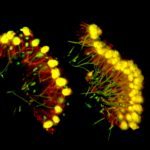Lien vers Pubmed [PMID] – 26598726
Lien DOI – 10.1098/rstb.2015.004320150043
Philos Trans R Soc Lond B Biol Sci 2016 Jan; 371(1685): 20150043
Eukaryotic cells convert external stimuli into membrane depolarization, which in turn triggers effector responses such as secretion and contraction. Here, we put forward an evolutionary hypothesis for the origin of the depolarization-contraction-secretion (DCS) coupling, the functional core of animal neuromuscular circuits. We propose that DCS coupling evolved in unicellular stem eukaryotes as part of an ’emergency response’ to calcium influx upon membrane rupture. We detail how this initial response was subsequently modified into an ancient mechanosensory-effector arc, present in the last eukaryotic common ancestor, which enabled contractile amoeboid movement that is widespread in extant eukaryotes. Elaborating on calcium-triggered membrane depolarization, we reason that the first action potentials evolved alongside the membrane of sensory-motile cilia, with the first voltage-sensitive sodium/calcium channels (Nav/Cav) enabling a fast and coordinated response of the entire cilium to mechanosensory stimuli. From the cilium, action potentials then spread across the entire cell, enabling global cellular responses such as concerted contraction in several independent eukaryote lineages. In animals, this process led to the invention of mechanosensory contractile cells. These gave rise to mechanosensory receptor cells, neurons and muscle cells by division of labour and can be regarded as the founder cell type of the nervous system.

